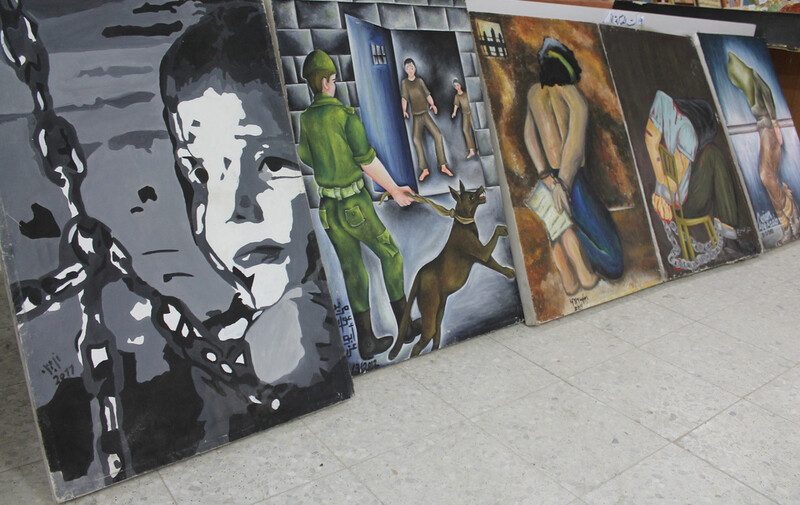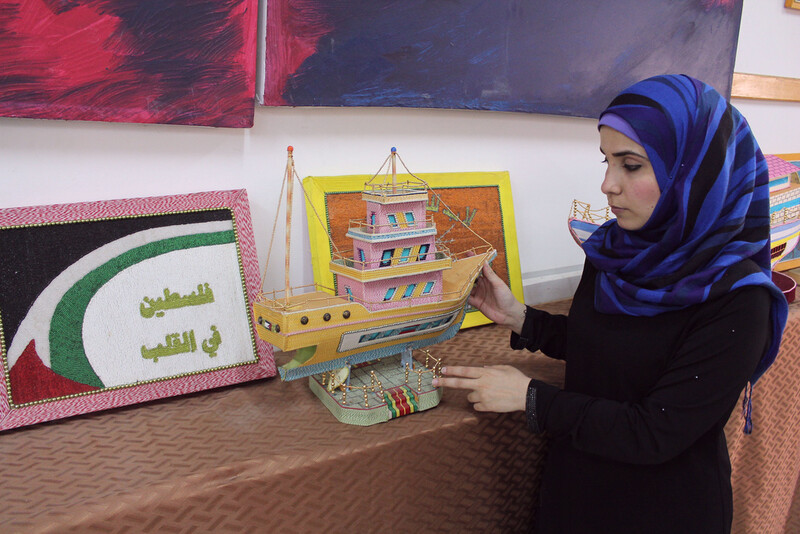The Electronic Intifada Gaza City 21 May 2013

Artwork by Palestinians in Israeli prisons is on display in Gaza governmental offices.
For former Palestinian detainee Abdelfattah Abu Jahil, prison art is a victory.
“At the beginning, it was really hard,” he said of painting, embroidery and sculpture during his first detention by Israeli forces in 1983. “It wasn’t allowed. We had to keep it hidden from the guards. And we had to smuggle the tools, like beads and threads, to make the art.”
That changed, he said, when a mass hunger strike forced the Israeli Prison Service to let Palestinian detainees keep and use art supplies.
“The greatest achievements of the prisoners’ movement were in 1985,” Abu Jahil said. “We went on hunger strike to force the Israelis to allow us to make art, among other things. I myself went on hunger strike for 79 days.”
Their success allowed art by detainees to flourish, he explained. “After the [Israeli Prison Service] allowed prisoners to make art, we were able to ask our families to send supplies, or buy them from the small shops in the prisons.”
Today, Abu Jahil, who was finally released from his fourth detention in 2002, continues to make art about detainees and the prisoners’ movement in Gaza.
Permanent collection
Drawing a stipend for his work from the Palestinian ministry of prisoners’ affairs, he now produces much of it for a permanent exhibition of prison art hosted by the ministry.
The collection, which opened in 2010, fills a hall in the ministry’s headquarters in Gaza City’s Tal al-Hawa neighborhood. It includes works of early prison art, like a gilded Dome of the Rock made from toothpaste and the copper foil in its tube, and sketches on thin tissue paper used to wrap fruits and vegetables in prison commissaries.
More extravagant pieces show the effects of the new influx of art materials to prisons in 1985, as well as continued participation in the project by freed detainees.
“Never surrender”

A mass hunger strike in Israeli jails in 1985 forced Israeli prison authorities to let prisoners use and keep art materials.
Imposing portraits of veteran prisoners, pastel landscapes of the Jerusalem skyline and the Gaza Strip’s countryside, and papier-mâché sculptures of Palestine’s topography and the Gaza-bound international aid ship, the Mavi Marmara, were obviously made in Gaza or transported here from prisons with the knowledge of the Israeli Prison Service. Some of the embroideries and smaller items were smuggled by visiting family members and detainees released at the end of their terms, ministry employees say.
“The exhibition shows that Palestinians never give in, they never surrender,” said ministry spokeswoman Mukarram Abu Alouf, who helps curate the exhibition. “We can be creative even under the most difficult circumstances. It also shows that Palestinians, no matter how many parties or categories we are divided into, can be united.”
The exhibition has several uses, she said. A number of delegations visiting Gaza come to see it. Local universities or other galleries often borrow its contents for their own exhibits. Much of it is currently displayed in a protest tent which the Waed Captive and Liberators Society erected at the site of Gaza City’s Saraya complex for Palestinian Prisoners’ Day on 17 April.
That site, incidentally, formerly contained one of three Israeli prisons that held Abu Jahil. “I was jailed in Nafha, Ashkelon and Saraya,” he said. “It was called the Gaza central detention before 1994. Airstrikes by Israeli warplanes demolished the compound on 28 December 2008.”
Emotional
“I made around fifty pieces of various kinds in prison,” he said of his seven years in detention. “A lot of it had to do with Palestinian folklore, for example, farmers, embroidered Palestinian dresses and old Palestinian houses. Another kind was about the Palestinian struggle against the Israeli occupation, like the Palestinian flag, map, or fighter. The third kind was the emotional one, making art for my mother, wife, children, or family.”
“My favorites are the emotional ones to my family,” he added. As an example, he cites an embroidery of beads depicting a heart between two candles he made one Mother’s Day.
“There are a lot of reasons to make this art,” he said. “First, to busy myself, to not have a lot of free time doing nothing. Secondly, to let my emotions out. Third, it is a cooperative effort. Another prisoner might make a drawing, then I would turn it into a picture. The fourth is that we when we make these things and send them to our families, it makes them happy. The fifth point is to prove to the world that even if detainees are in prison, under pressure and torture, we can still make something from nothing. All the pressure and torture has not affected our mental states.”
Rawda Habeeb, a social researcher at the ministry whose work also appears in the exhibition, remarked that art was a way to bring Palestinian heritage into the prisons. “We loved doing it because it’s part of the Palestinian culture, which we are all, of course, proud of.”
Israeli forces captured Habeeb on 20 May 2007 and sentenced her to two-and-a-half years. Like many detainees from the Gaza Strip, she was captured while traveling through the Erez checkpoint for medical treatment. She was freed on 4 October 2009, the last of twenty female detainees released by Israel in exchange for a video of a captured Israeli soldier who was held as a prisoner of war by Palestinian resistance groups.
Teamwork

Ministry spokesperson and exhibition curator Mukarram Abu Alouf with some of the artwork on display.
Her cousin Yousef al-Zaq was the 21st prisoner released in the deal, along with his mother, Fatima al-Zaq, Habeeb’s aunt. It was his second birthday, making him the world’s youngest released prisoner, his family said. He started school at a Gaza kindergarten last September.
“We made a lot of art, embroidery, since it is from the Palestinian culture,” Habeeb said of her detention in Sharon prison. “We made embroidered pillows, pictures, blankets and tissue boxes.”
“It was teamwork,” she added. “For example, when we wanted to make an embroidered picture, one would do the embroidery, another the wooden frame, a third the glass. We taught each other how to do the embroidery work.”
While imprisoned, Habeeb began studying social service. After her release, she completed a degree at Gaza City’s al-Azhar University and focused on life outside prison and with less art.
“I didn’t continue after being released,” she explained. “Such work requires a lot of spare time, which I don’t have. I have a husband, four children and a job instead.”
Abu Jahil, who lived on water and salt for 79 days to win his pens and brushes, has no intention of laying them down.
“Prisoners can be creative,” he said. “We always survive. Being captured and detained in Israeli prisons is not the end of our struggle. We will always keep fighting.”
All images by Joe Catron.
Joe Catron is a US activist in Gaza, Palestine. He co-edited The Prisoners’ Diaries: Palestinian Voices from the Israeli Gulag, an anthology of accounts by detainees freed in the 2011 prisoner exchange, blogs at joecatron.wordpress.com and can be followed on Twitter @jncatron.





